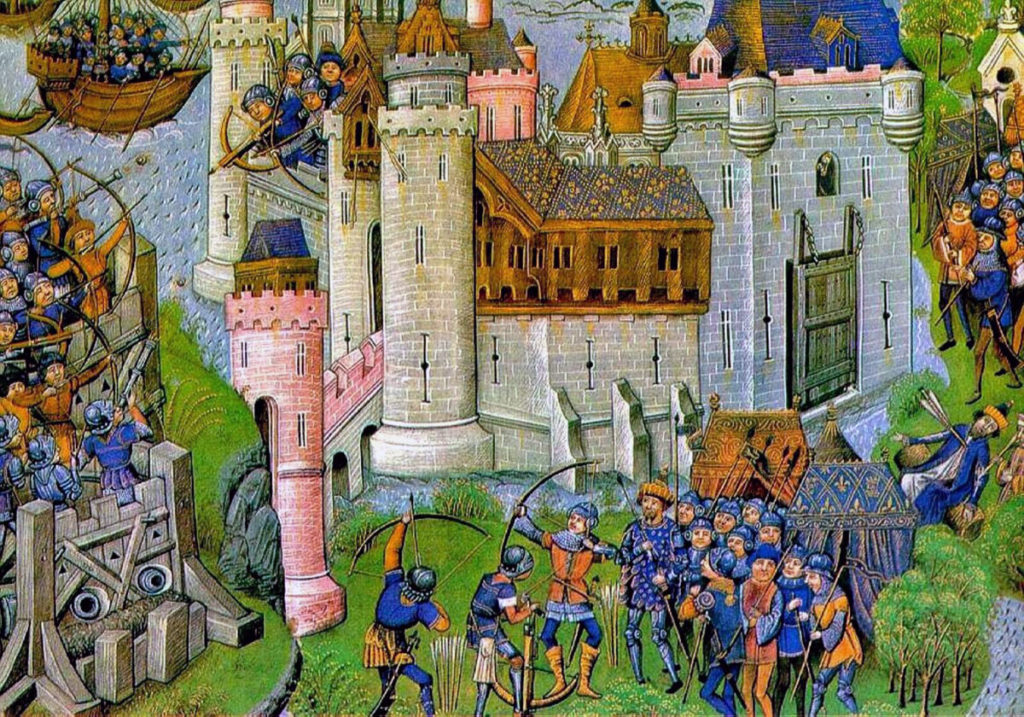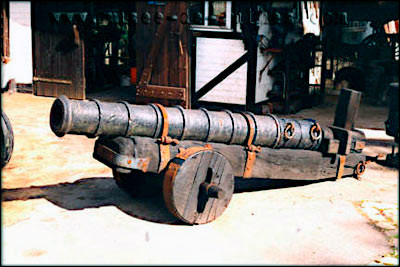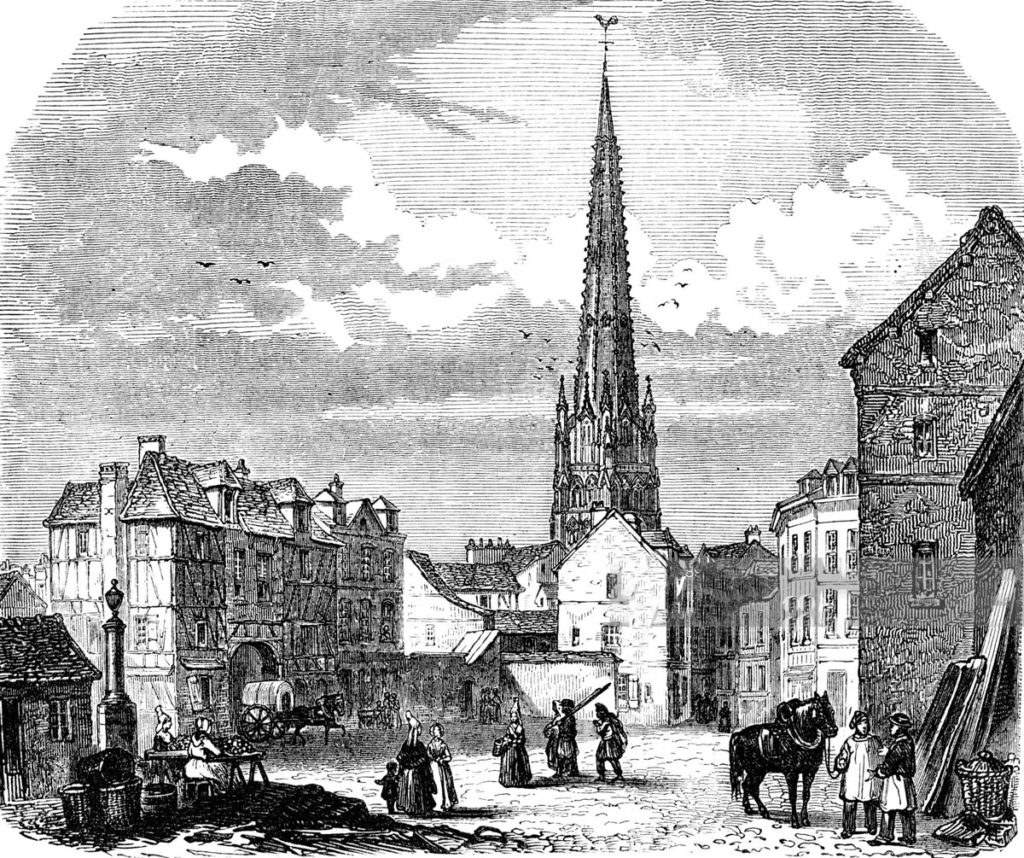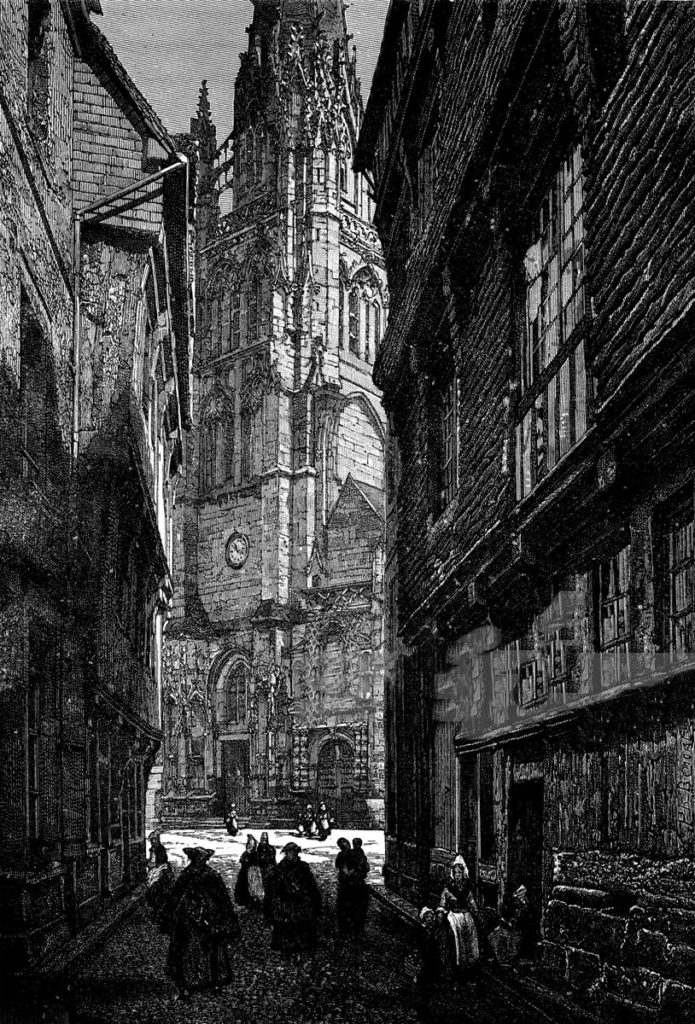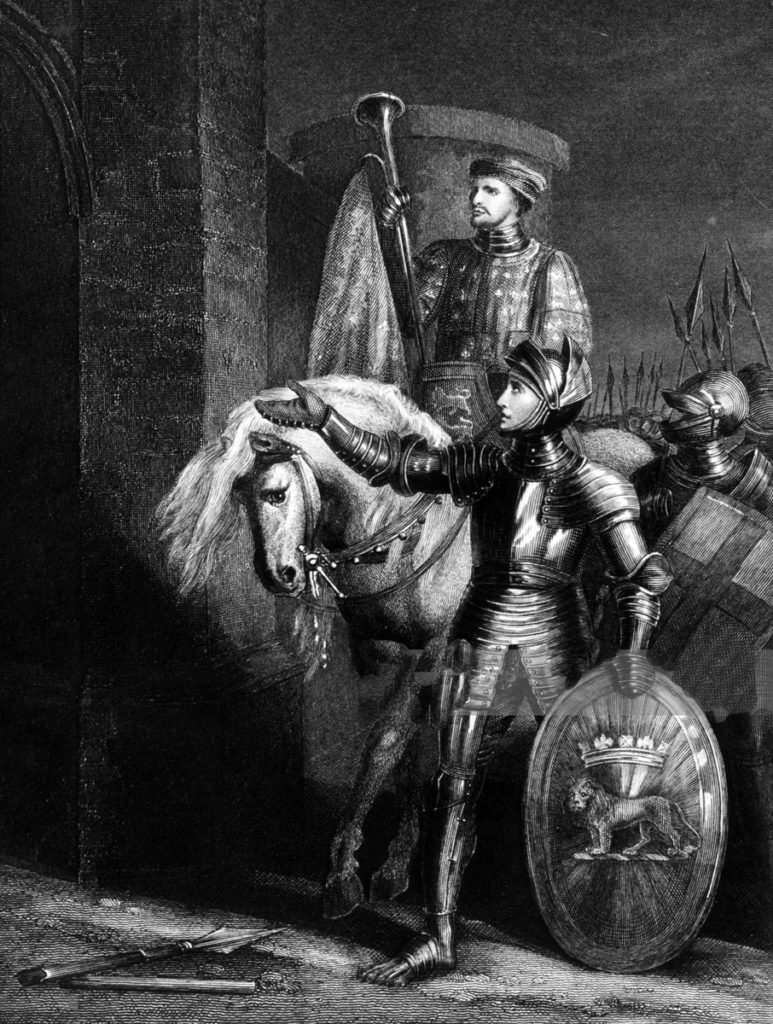The English capture of the port of Harfleur in the Hundred Years War that gave King Henry V the base he needed for his invasion of France in August 1415
The previous battle of the Hundred Years War is the Battle of Shrewsbury
The next battle in the British Battles series is the Battle of Agincourt
War: Hundred Years War.
Date of the Siege of Harfleur: 17th August 1415 to 22nd September 1415.
Place of the Siege of Harfleur: On the Normandy coast in France at the mouth of the River Seine.
Combatants at the Siege of Harfleur: An English army and fleet besieged the French garrison and inhabitants of the town.
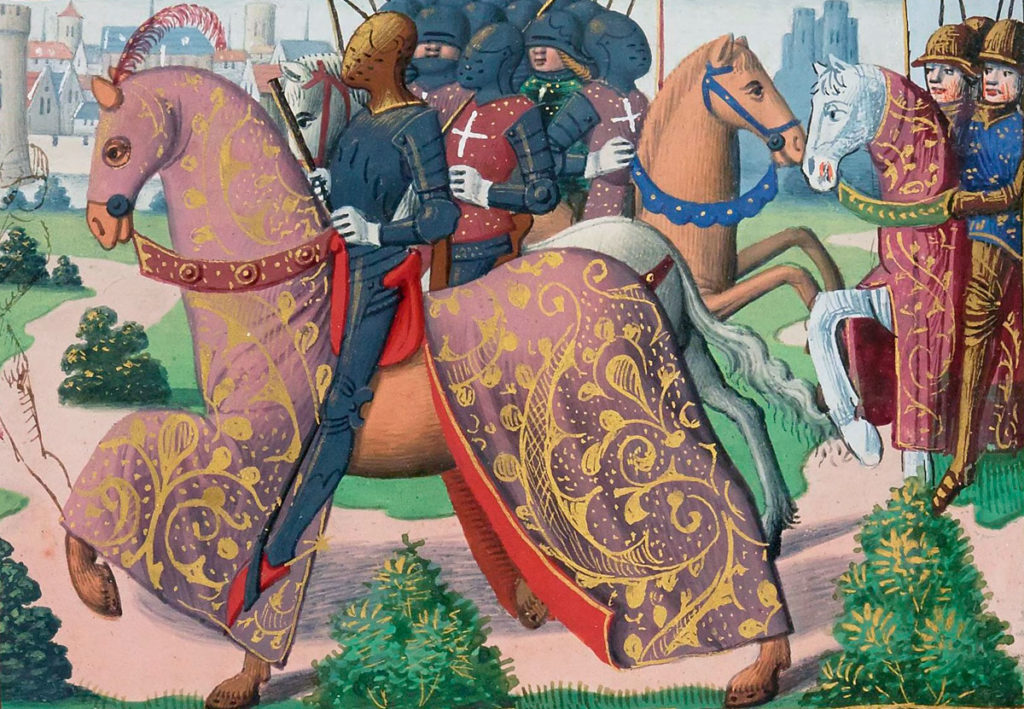
Commanders at the Siege of Harfleur : King Henry V commanded the English army and fleet.
Raoul de Gaucourt commanded the French garrison.
Size of the armies at the Siege of Harfleur: King Henry V’s army numbered around 16,000 men. His fleet was manned by around 20,000 sailors.
The French garrison comprised 400 men-at-arms with the armed inhabitants of the town and some crossbowmen.
Uniforms, arms and equipment at the Siege of Harfleur: Mounted knights and men-at-arms increasingly wore steel plate armour with visored helmets. Their weapons were lance, shield, sword, various forms of mace or club and dagger. Many carried two-handed swords in battle. Each knight wore his coat of arms on his surcoat and shield.
English archers carried a powerful bow, capable of many aimed shots a minute. In massed formations in battle these archers were a devastating force.
For hand-to-hand combat archers carried swords, daggers, hatchets and war hammers. They wore jackets and loose hose. Archers’ headgear was a skull cap either of boiled leather or wickerwork ribbed with a steel frame.
The garrison of Harfleur comprised knights, men-at-arms and cross bowmen.
The crossbow had a shorter range and slower rate of fire than the longbow, so that crossbowmen were not capable of influencing the outcome of battles of the time as were the English and Welsh longbowmen.
In addition many of the town’s male residents fought with the garrison using whatever weapons they possessed or could lay their hands on.
Artillery was now a regular and powerful arm of a medieval army, used principally in siege warfare rather than on the battlefield due to the difficulty in moving cannon.
Against town walls guns were a devastating weapon, as in the siege of Harfleur.
Winner of the Siege of Harfleur: The French garrison of Harfleur surrendered to the besieging English army.
Events leading to the Siege of Harfleur:
On 7th August 1415 King Henry V of England boarded his flaghip ‘Trinity Royal’ in Southampton and, gathering the rest of the English fleet, sailed for France.
Arriving in the mouth of the River Seine, on 14th August 1415 the English army began to disembark on the Normandy coast at Harfleur.
Henry’s first target was to capture the town of Harfleur to be used as the base for his invasion of France.
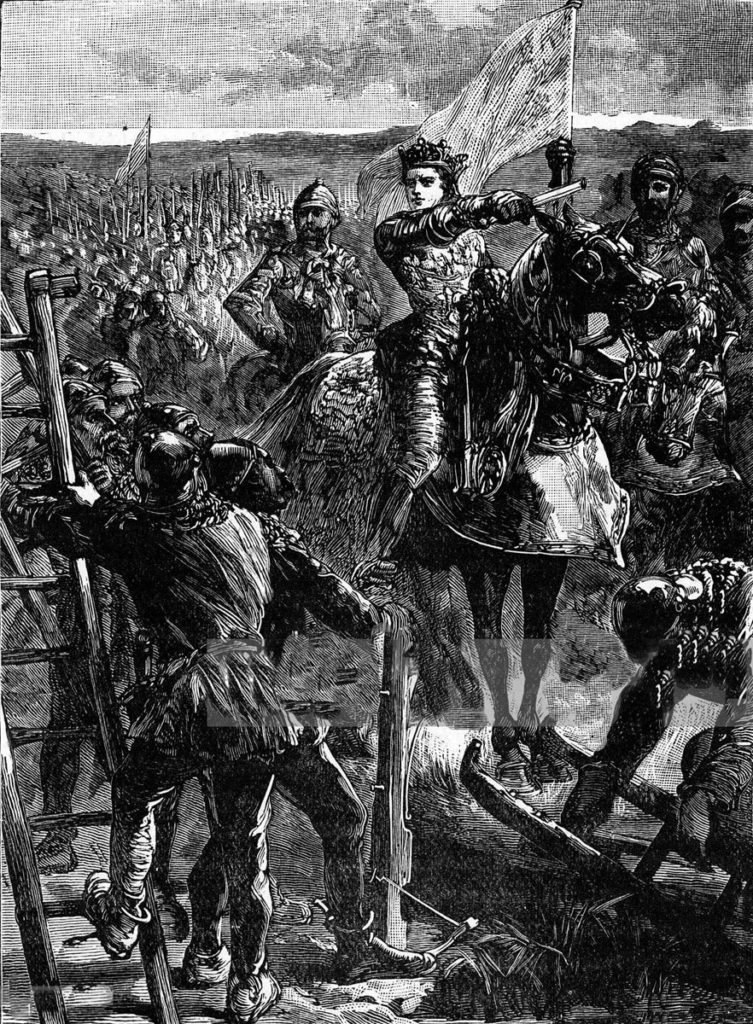
The English army was ashore by 17th August 1415 and Henry began his attack on Harfleur.
While the French were well aware of Henry’s intention to invade France and that his army was assembled around Southampton and ready to sail, the French King Charles VI and his advisers assumed that Henry would land further west on the Cherbourg peninsular, the nearest point on the French coast to Southampton.
There was no expectation that the English would land in the mouth of the River Seine and attack Harfleur.
The French garrison in Harfleur reflected this lack of readiness, being only 30 men.
In the 15th Century Harfleur lay on the edge of the Seine estuary.
The River Lézarde flowed through the centre of Harfleur and widened to form the town’s harbour on the edge of the estuary.
The population of Harfleur, numbering 6-8,000 made their livings from the Atlantic sea trade and from piracy.
The town was fully walled with 26 towers and 3 fortified gates.
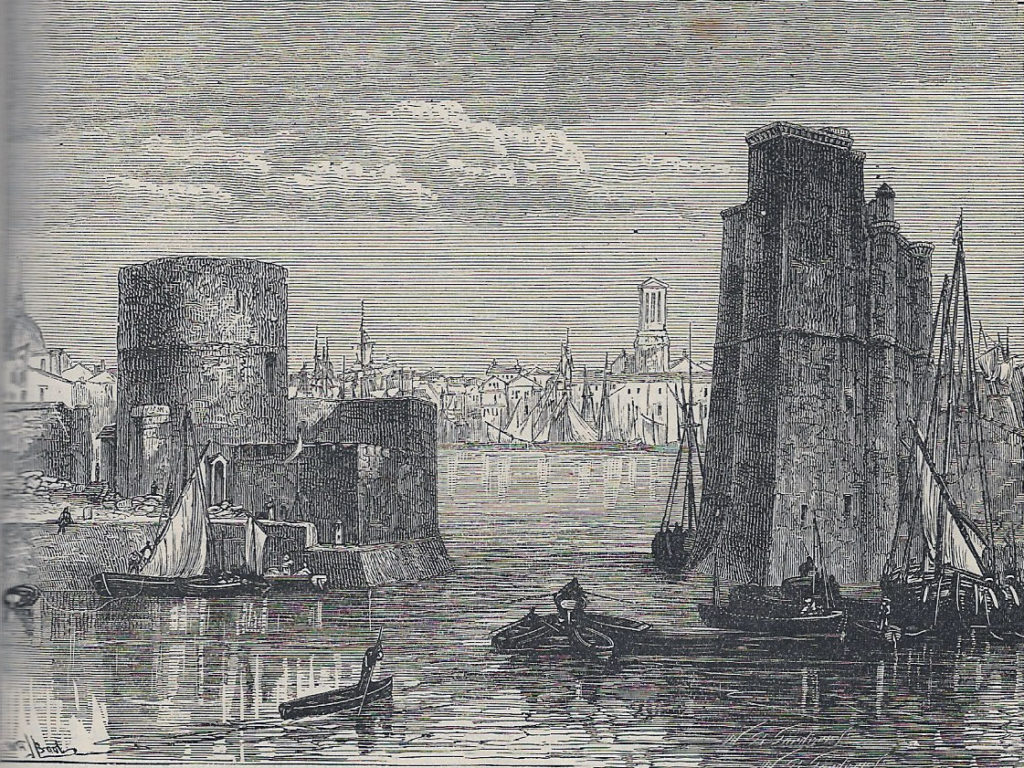
The two and a half miles of wall were further defended by a double line of ditches and moats.
In the last few weeks before the siege the defences of the harbour were improved with sharpened stakes embedded in the entrance and wooden barbicans erected in front of the fortified gates.
The town’s defences were overlooked by Mont Cabert to the east and Mont Lecomte to the west.
The French high command was criticised for failing to confront the English landings, when Henry’s army was at its most vulnerable.
Once the landings had taken place the French acted with despatch.
A line of ships was chained across the entrance to the harbour.
The sluices on the River Lézarde were closed so that the area north of the town flooded.
The creation of this inundation delayed the English in surrounding Harfleur, enabling the French commander, Raoul de Gaucourt, to enter the town with 300 men-at-arms to reinforce the garrison.
On 17th August 1415 English troops occupied Mont Lecomte blocking the west side of the town.
On 18th August 1415 the Duke of Clarence made his way past the flooded River Lézarde to seal off the town from the east by occupying Mont Cabert.
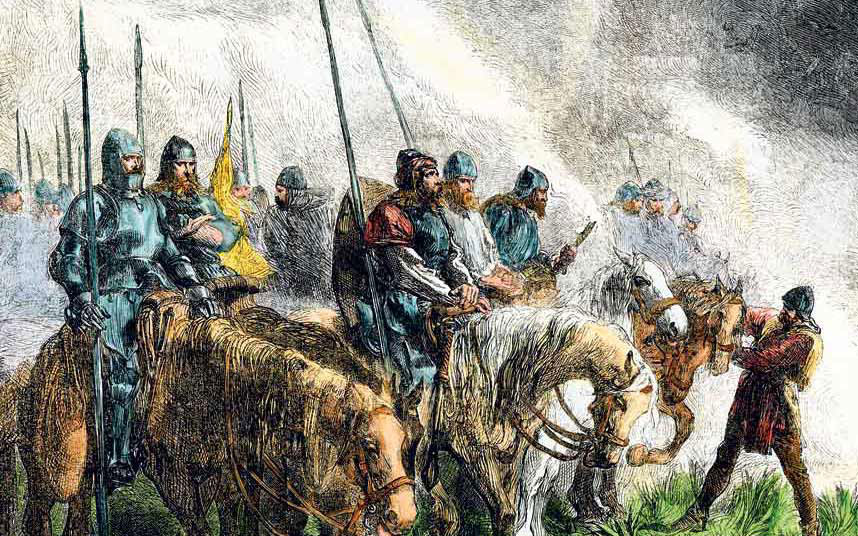
The flooded Lézarde sealed off the town on the north side, English troops patrolling the inundation in small boats.
While marching around Harfleur the Duke of Clarence intercepted a large waggon-train carrying supplies for the town including much needed gunpowder.
This was the last opportunity to bring supplies into Harfleur.
From then on the only communication with Harfleur was by way of a small galley rowing across the Seine Estuary from Honfleur.
On 19th August 1415 Henry V summoned the Harfleur garrison to surrender.
This summons was rejected by the town authorities and the siege of Harfleur began.
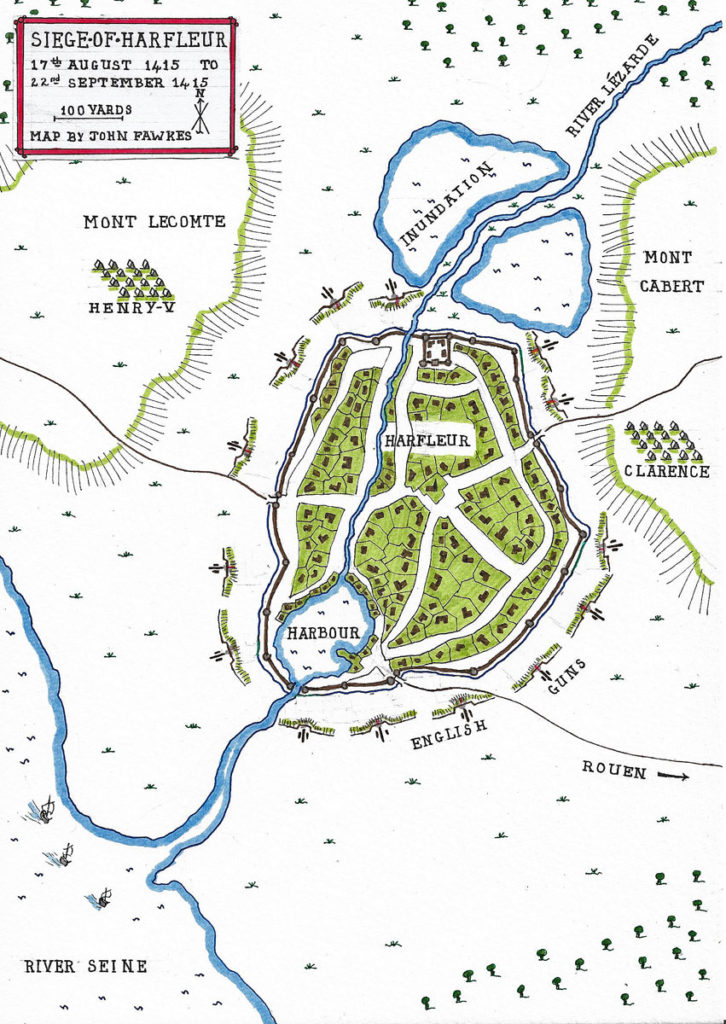
Account of the Siege of Harfleur:
English guns were dug into prepared positions situated round the walls of Harfleur and the siege of the town was conducted by way of a constant artillery barrage, interspersed with assaults on those parts of the walls thrown down by the English gunfire.
The English gunners served in shifts to enable a near-constant fire to be maintained on the walls.
The inhabitants worked hard to defend their town, overnight repairing damage caused by the English guns during the day.
English engineers dug mines under the town walls and the garrison dug counter-mines.
The English inched nearer to the fortifications enabling their guns to fire on the walls from increasingly shorter range.
The English threw heaps of wooden faggots into the town’s moat to fill it in. The garrison emptied barrels of burning pitch onto the faggots to destroy them.
The sluice gates of the river were shut to raise the level of the moat and to flood the besiegers’ mining operations.
In spite of these ingenious activities the English lines inched towards the walls of Harfleur.
The French King Charles VI appointed Marshal Boucicaut to command the army of relief and in late August 1415 proclaimed a general summons throughout France for an army to assemble.
Efforts were made by the French to hire ships in Flanders and Brittany and to repair the galleys lying rotting in the Royal Arsenal in Rouen.
The French left the organising of a campaign of relief for Harfleur too late.
The garrison of Harfleur was suffering heavy casualties and supplies were running out. Many of the surviving garrison were ill.
The defences were damaged by English cannon-fire beyond the capacity of the garrison to carry out effective repairs.
On 15th September 1415 the French commanders in Harfleur sent a parlementaire to the Duke of Clarence asking for terms of surrender and seeking a truce until 6th October 1415 for negotiations to take place.
The garrison was given a truce until 18th September 1415.
Negotiations made little progress and on 17th September 1415 Henry V sent a message into the town saying that unless Harfleur surrendered by 1pm the next day he would launch an assault.
The garrison could see the storming parties assembling, including sailors from the English ships moored along the coast.
That evening the garrison sent a message to Henry offering to surrender on 22nd September 1415 if no relief arrived before then.
These terms were accepted and the garrison was permitted to send a deputation to the French court to inform them of the terms.
A party of twelve senior members of the garrison left the town and met the Dauphin at Vernon to inform him of the terms agreed.
It was purely a matter of form as it was already too late to relieve Harfleur.
The Dauphin informed the delegation that his army was not strong enough to face Henry’s English army in battle.
On 22nd September 1415 Raoul de Gaucourt appeared before King Henry V with the keys to Harfleur, accompanied by the leading citizens and officers of the garrison.
Raoul surrendered the keys to Henry, the gates of the town opened and the English army entered.
A party of French diehards continued to resist in the towers at the main gate and had to be overcome.
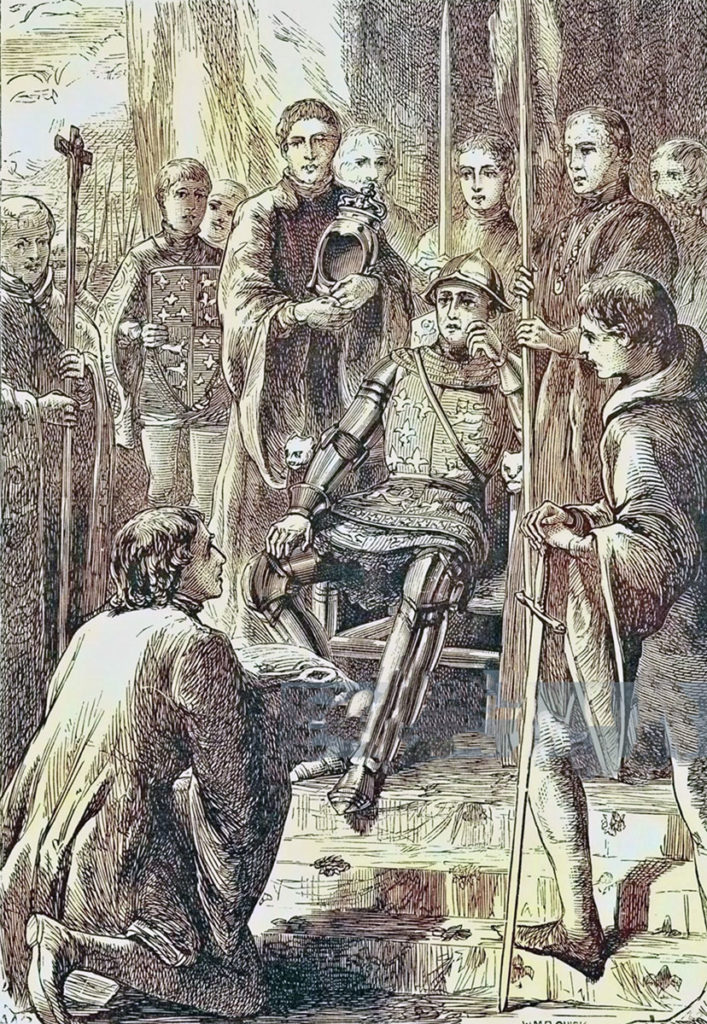
The survivors from the garrison, some 260 men, were treated as prisoners of war and subject to ransom.
Able bodied townsmen who swore an oath of allegiance to Henry were permitted to remain in the town. The rest of the population, including women, children and the aged and infirm, were forced to leave.
Harfleur became the base for the English invasion of France.
Casualties at the Siege of Harfleur:
Around 200 members of the small French garrison died in the Siege of Harfleur along with a substantial number of the civilian population who fought with the garrison against the English.
Losses in the English army were substantial.
In the hot weather dysentery took a hold in the besiegers’ camps and killed many more Englishmen than died in the fighting, around 2,000.
Among the dead were Bishop Courtenay and the Earl of Suffolk.
The total English casualties during the siege of Harfleur were probably around 3,000 dead.
Some 5,000 were too ill to continue with the campaign in France and had to return to England. Among these were the Duke of Clarence and the Earl of Arundel, who died later in 1415.
Follow-up to the Siege of Harfleur:
Henry’s army was so reduced that the King’s Council advised him to abandon the invasion of France and return to England.
This Henry refused to do, but his plans were substantially modified.
A garrison of 1,200 men was left to hold Harfleur under the Earl of Dorset, while Henry marched north-east with the remaining army of 900 men-at-arms and 5,000 archers.
References for the Siege of Harfleur:
Cursed Kings The Hundred Years War Volume IV by Jonathan Sumption
The Art of War in the Middle Ages Volume Two by Sir Charles Oman.
The Hundred Years War by Burne
British Battles by Grant.
The previous battle of the Hundred Years War is the Battle of Shrewsbury
The next battle in the British Battles series is the Battle of Agincourt
